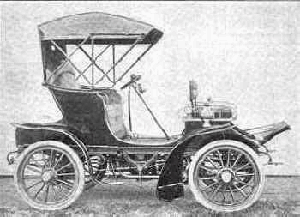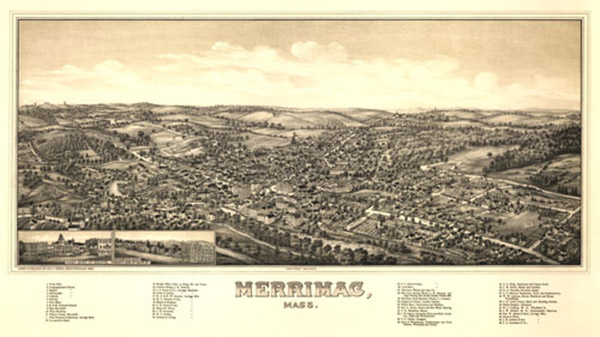Merrimac, Massachusetts is a small residential community with a population of around 6,000. Located in northeastern Massachusetts between Amesbury and Haverhill, this small town was once an important center for the carriage-making industry. The town’s numerous carriage factories were producing top quality, award winning carriages until the beginning of the automobile era.
Early Merrimac History
The Merrimac, Massachusetts of today was once part of a group of towns that made up the Merrimack Plantation. Merrimack Plantation was established in 1638, and included today’s towns of Salisbury, Amesbury, and Merrimac. In 1668, Amesbury became its own town and the area that would become Merrimac was called the West Parish, and was later called West Amesbury.

In Colonial times, West Amesbury (now the town of Merrimac) functioned as a port for goods going in and out of the area, and a ferry was set up to travel across the Merrimack River. By the mid 1800s, boats were running between West Amesbury and Newburyport carrying local goods downriver, and items such as groceries and other necessaries upriver to the port.
For a time during the 1700s. chaise makers such as Michael Emery, William Little, and Stephen Bailey were producing two-wheeled chaises. By the 1800s, however, four-wheeled carriages such as landaus and broughams were rapidly replacing the two-wheeled chaise. This was to be the beginning of West Amesbury’s famous carriage industry.
From West Amesbury to Merrimac
Carriage makers in East Amesbury (today’s town of Amesbury) began to mass-produce inexpensive carriages such as the brougham. Manufacturers in West Amesbury concentrated on making high quality carriages such as the landau in smaller quantities.
This difference in production was a main cause for the decision for West Amesbury to split from East Amesbury and become its own town. Merrimac, which means “swift water place” in the American Indian language of the area, was established as its own town in 1876.
Merrimac’s Carriage Manufacturing Industry
The Massachusetts Gazetteer of 1890 said of the town: “Merrimac is a thrifty and attractive manufacturing town situated on the north bank of the Merrimack River. The principle business is carriage making, in the different departments of which, in numerous shops, some 500 men are engaged.”
The mid 1800s marked the peak of Merrimac’s carriage-making, and by 1888, there were nineteen carriage-making shops as well as other companies related to the carriage-making industry. Between 1881 and 1889, Merrimac’s carriage factories were making 1,500 quality carriages per year. Companies such as J.B. Judkins and Company, Loud Brothers, and H.G. & H.W. Stevens Carriage Works were just a few of those bringing prosperity and fame to this small town.
Many companies did not manufacture carriages directly, but instead provided important products for the manufacturing companies. G.W. J. Murphy made “Murphy Buttons” which were actually brass fasteners used to attach curtains to carriages and later to automobiles. John Poyen and Herbert Delano owned a carriage finding store which supplied everything necessary for the trimming of carriages. Threads, ribbons, needles, fringes, and stuffing were just a few of the products found at this store which was known as the “largest and best stocked in New England”.
J.B. Judkins Company
The main source of the town’s prosperity came from the actual carriage-making factories, and J.B. Judkins Company was one of the largest and most successful. Founded in 1857 by John B. Judkins and Isaac B. Little, this company built high quality carriages such as the Rockaway, Landau, and Victoria. These carriages were sold to William P. Sargent Company, F.F. French & Company, and to companies in New York. The carriages built at this factory were of such high quality, that J.B. Judkins Company was awarded a gold medal for its carriages at the 1876 Centennial Exposition in Philadelphia.
By the end of the 1890s, carriage-making was on the wane, and automobile manufacturing was taking its place. J.B. Judkins Company was more than ready to make the shift from quality carriages to high quality automobile bodies. In 1892, the company began to make automobile bodies for the Electric Vehicle Company of Hartford, Connecticut.
After the last carriage was made in 1910, J.B. Judkins became the area’s largest employer of skilled automobile craftsmen. Before the Great Depression slowed manufacturing, the company produced automobile bodies for companies such as Pierce Arrow, Lincoln Cadillac, and Packard. For a brief time, the company made modular diners, a few of which are still in existence. By 1945, the J.B. Judkins Company was closed and sold, and Merrimac’s days of being a factory town were over.
Merrimac Today
What was once the Thomas Hoyt Memorial Library is now the home of the Merrimac Historical Museum. The museum, built in the Tudor style, with stained glass windows designed by Charles J. Connick, is filled with pictures, documents, and artifacts from Merrimac’s prosperous carriage making days. Buildings and homes lovingly preserved can be seen in the town, and family names such as Emery, Hoyt, Sargent, Clement, and Sawyer are living links to Merrimac’s past.
An historic trail was created to highlight points of interest throughout the town, and thirty numbered site markers can be found along the trail. Merrimac is now a residential community, but there is still pride in the town’s rich carriage making history.
Sources:
- Hoyt, Jeffrey W., Merrimac Massachusetts Historical Trail Guide, Merrimac Historical Commission, 2007.
- Merrimac Massachusetts History, Global Oneness
- Merrimac, Essex, Ma Gen Web, Esssex County Massachusetts Geneology Project, 2006.
- Theobald, Mark, Coachbuilt, 2004.








